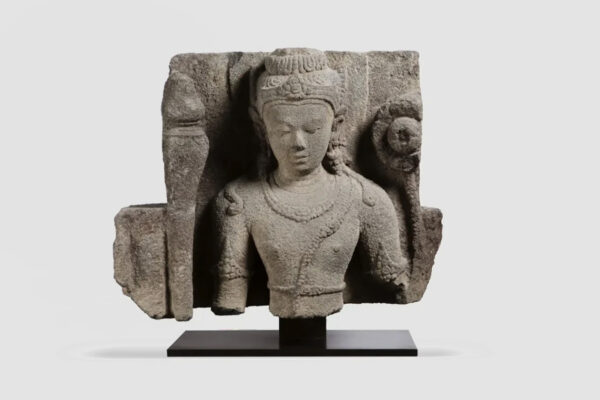Vietnam estimate
“Sell where the market demands” is the motto of Millon, the first Western auction house to establish a presence in Vietnam.
Do you own a work of art from Vietnam and would like to appraise it? Our auctioneers and experts specializing in Vietnamese art will appraise your Vietnamese works of art free of charge and help you sell them at auction.
Receive a confidential valuation of your works of art from Vietnam within 48 hours.
Why ask for a free estimate?
Asium is Europe’s leading appraisal site specializing in Asian art. Since 2014, Asium has specialized in buying and selling Asian art.
Within 48 hours, we offer you a first estimate of your work. This estimate can be followed by a physical appointment if required. We also offer guaranteed sales solutions throughout Europe.
Table of Vietnamese art price ranges by category
| Subject Category | Average low price range | Average price range high | Example |
| Vietnamese paintings | 20 € – 500 € | 10 000€ – 400 000 € | Paintings by Tran Bihn Loc |
| Bonze statues from Vietnam | 100 € | 10 000 € | Tonkin statues |
| Vietnamese lacquers | 5000 € | 900 000 € | Pham Hau screen |
| Vietnamese ceramics | 150 € | 25 000 € | Ceramics from the Lê Dynasty |
These price ranges in euros give you a general idea of the values observed at Asian art auctions, but it is important to note that actual prices may vary considerably depending on the specific circumstances of each work.
Record prices for Vietnamese artworks
The auction record for a Vietnamese painting is held by Mai Trung Thu’s “Portrait de Mademoiselle Phuong”. This oil-on-canvas painting, created in 1930, sold for $3.1 million at a Sotheby’s auction in Hong Kong in April 2021.
Other Vietnamese artists have also reached new heights at auction. For example, Lê Phô’s painting “Tea and Sympathy” sold for $1.36 million in October 2022.
Similarly, Vu Cao Dam set a world record with a work that sold for 331,250 euros.
How does the Asium estimate request work?
Free online estimate:
- Send us photos of your artwork
- Our experts study your work and estimate its value
- Receive your estimate within 48 hours!
Free expertise days :
Come and visit us at one of our many appraisal days! Our experts travel the roads of France to sell where the market demands.
In-home expertise
Is your object too bulky? Our experts will come to you after an initial
Recognizing a valuable Vietnamese work of art
To recognize a valuable Vietnamese work of art, here are several criteria for assessing its authenticity:
Dating :
Vietnamese artworks rely on a number of singular details to identify them.
- First of all, there’s the artistic style, which allows us to situate the work within a particular movement.
- The artists’ signatures, seals or inscriptions on the works are also essential for identifying the period of creation.
- The materials used, such as pigments or support, can also indicate a specific era, as some were only available from certain historical periods.
There are many periods in Vietnamese history that are significant in terms of the testimony they bear in art. For example, ancient Vietnamese paintings may have distinct characteristics from those created in contemporary times.
Currently, the most sought-after works are those by the Hanoi School, between tradition and modernity. For example, a painting by the famous Vietnamese artist Le Pho (1907-2001), entitled Thé et sympathie (Tea and Sympathy) sold for 1.1 million euros. The artist’s signature and distinctive style, combining Vietnamese tradition and Western technique, were key factors in determining the work’s value.
Type of work :
To identify valuable Vietnamese works of art, we need to examine their authenticity and artistic quality. In the 19th century, many works were produced for export, often decorative and adapted to Western tastes, but less authentic. By contrast, pieces of real cultural value feature traditional techniques, local materials and Vietnamese themes, such as rural or Buddhist scenes.
A notable example is Pham Hau’s Paysage aux jonques, a lacquer made in 1943 and sold in 2021 for around 650,000 euros. This work, using the sanded lacquer technique with fine details and rich colors, depicts a typical Vietnamese landscape, making this piece rare and highly prized by collectors.

Source :
Vietnam, with its rich history and varied cultural influences, has seen its art evolve under the influence of French colonization (1858-1946) and the American war (1955-1975). Works from the 19th and 20th centuries often reflect a blend of Western techniques. The provenance of works, including ownership history, exhibitions and authenticity documents, is crucial in assessing their value.
A provenance dating back to colonial times or linked to influential artists such as Le Pho or Mai Trung Thu increases the value of a work. For example, Mai Trung Thu’s Femmes et enfants au bord de la rivière, influenced by French colonization and sold for around 530,000 euros at Sotheby’s in 2023, perfectly illustrates this mix of influences.
Signature and seals :
Signatures and seals are essential for identifying and dating Vietnamese works of art. Artists, particularly those trained at the École des Beaux-Arts de l’Indochine, often sign in Latin or Chinese characters, accompanied by a red seal, engraved in stone or wood, incorporating Vietnamese cultural symbols. The presence of an authentic signature and seal confirms provenance and increases the work’s value. For example, Vu Cao Dam signs and affixes a red seal with stylized Chinese characters to his silk paintings, reinforcing the authenticity of his works.
However, for modern or contemporary pieces, only a certificate of authenticity issued by the artist, his committee or an auction house expert can guarantee the value.
Artistic quality
Artistic quality, of course, plays a key role. For example, Un Bouddha sold at Christie’s in 2016 for around 150,000 euros. Quality Vietnamese religious sculptures, particularly those in bronze, are highly sought-after by international collectors.
Conservation status
The state of conservation of Vietnamese art objects is essential in assessing their value, as Vietnam’s high humidity affects materials such as wood, lacquer and textiles. Old wooden sculptures, sensitive to humidity, may show cracks or mildew. Lacquer works, typical of Vietnamese art, are vulnerable to light and heat, causing discoloration and cracking. A careful inspection of their condition is therefore essential for an accurate appraisal.
Artist’s reputation
A work by a renowned Vietnamese artist, such as Nguyễn Phan Chánh, Le Pho or Bùi Xuân Phái, can fetch a high value. For example, Nguyễn Phan Chánh’s inks on silk, illustrating daily life, can fetch up to 600,000 euros. Works linked to recognized movements, such as the Indochina School of Fine Arts, are also sought-after: a screen by Nguyen Gia Tri sold for 375,500 euros at Osenat. In short, a valuable Vietnamese work of art is distinguished by its authenticity, quality, condition, rarity, reputation of the artist and cultural importance.
Consult our Vietnamese art experts to confirm the value of a specific work!

Record sales of Vietnamese art by category
Some Vietnamese works achieved record prices on the world art market. Here’s a look at record sales results for Japanese art at auction, covering various fields such as paintings, prints, ceramics, and objets d’art.
Here are a few sales records in different categories of Vietnamese art, covering various mediums and artists:
1. Silk painting
- Nguyễn Phan Chánh, Les Couturières
- Sale record: €945, 233 (Christie’s Hong Kong, 2020).
This work on silk illustrates Nguyễn Phan Chánh’s mastery of traditional techniques while depicting scenes from Vietnamese life.
2. Oil painting
- Lê Phổ, Figures in a Garden
Sale record: 1.17 million euros (Sotheby’s Hong Kong, 2022).
Lê Phổ, based in France, is famous for his paintings blending Eastern and Western influences. This record shows the popularity of his works on the international market.
3. Lacquer painting
- Pham Hau, Golden Sunset over Halong Bay
- Sale record: 896,531 euros (Bonhams, 2019).
This masterpiece of lacquer painting is emblematic of the virtuosity of Pham Hau, recognized as the master of this technique.
4. Sculpture
- Vu Cao Đàm, Kneeling Woman (bronze)
Sale record: €204,573 (Chrtistie’s, Hong Kong, 2019).
Vu Cao Đàm is known for his bronze sculptures and paintings, often inspired by delicate, elegant female forms.
5. Contemporary art
- Danh Vo, VJ Star (2010)
- Sales record: €672,000 (Phillips London, 2015).
This contemporary Vietnamese artist explores themes of identity, memory and history through conceptual installations.
6. Vietnamese ceramics
- Lamp / candlestick Vietnam, Le dynasty, first half of the 17th century
- Record sales: €24,000 (Bonhams, 2021).
This rare object illustrates the exceptional skills of Vietnamese craftsmen of the Lê period, particularly in the production of elegant, sophisticated ceramics.

Our experts in vietnam estimate
-

TaHsi CHANG
Specialist in the arts of VIETNAM and CHINA
-

Eunbi HA
Your questions, our answers
What Vietnamese artworks can Asium appraise?
Asium proposes a team of experts able to answer all your requests. For Vietnamese art, we offer free appraisals for all types of Vietnamese works of art:
-
- Paintings by Le Pho, Tran Bihn Loc, Mai Thu or Vu Cao Dam.
- Lê Dynasty ceramics, porcelain with blue-white decoration
- Sculptures from Tonkin, bronze sculptures from Cham Art.
- Lacquerware by Nguyen Gia Tri, Pham Hau or Nguyen Van Ty.
What is the auction price range for a Vietnamese work?
Depending on rarity and type, Vietnamese works sell for between €50 and €900,000 at auction.
-
- Paintings by Le Pho, Tran Bihn Loc, Mai Thu or Vu Cao Dam.
- Lê Dynasty ceramics, porcelain with blue-white decoration
- Sculptures from Tonkin, bronze sculptures from Cham Art.
- Lacquerware by Nguyen Gia Tri, Pham Hau or Nguyen Van Ty.
What is the auction price range for a Vietnamese work?
Depending on rarity and type, Vietnamese works sell for between €50 and €900,000 at auction.
Previously appraised by Asium
The Asium estimation service is...

Simple
and free
A few photos of your work, a few words of description and you're all set !

Fast
but not too fast
Our experts are serious, they take the time to research and get back to you within a week.

Reliable
and confidential
Our auctioneers are the Sherlock Holmes of the art market.































